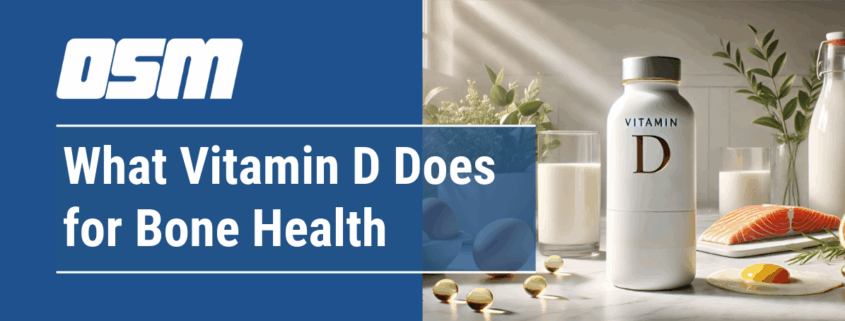What Vitamin D Does for Bone Health
Article featured on OrthoInfo
- Without Vitamin D, our bodies can absorb only 10 to 15% of the calcium we consume.
- Children who lack Vitamin D develop a condition called rickets, which causes bone weakness, bowed legs, and other skeletal deformities.
Today, doctors are seeing an increase in the number of children with rickets and Vitamin D deficiency. This article focuses on the reasons for the increase and what parents can do to improve their children’s bone health — as well as their own.
What Is Vitamin D All About?
Vitamin D is really not a vitamin. Vitamins are special nutrients that the body needs but cannot make, so they must be obtained from what we eat or by supplements. Because our bodies can make Vitamin D in our skin when the skin is exposed to sunlight, Vitamin D is considered a hormone.
How did we learn about Vitamin D and its importance?
When people stopped working in the fields and started spending most of their days in factories or schools, rickets began to be a problem — in fact, it was commonly seen during winter months in areas with heavy smog blocking the sun, and especially in northern locations far from the equator.
Around 1920, people noticed that children who took cod liver oil rarely got rickets. This led to the discovery of Vitamin D and the beginning of Vitamin D supplementation of the diet.
Why is there a new focus on Vitamin D today?
Recent research has stressed the importance of Vitamin D, not just for good bone health, but also for:
- Brain development
- Improving immunity
- Possibly preventing chronic disease when we are older.
It has been linked to:
- Brain and heart health
- Obesity
- Mood
- Autoimmune and immunologic disorders
- Infections, like the flu and COVID-19
Yet, many children today are not getting enough Vitamin D. There are several reasons for this, including the fact that very few foods contain substantial levels of Vitamin D. Even the healthiest of diets will probably not provide a child with adequate Vitamin D, especially as kids get bigger. As a result, current recommendations are for children to take a daily Vitamin D supplement.
Changes in lifestyle have also played a part. Several aspects of modern-day childhood impact Vitamin D intake:
- Children today spend hours in front of a computer or on phones or tablets, rather than playing outdoors. It is well documented that fitness levels among children are on the decline and obesity levels are rising.
- Children should be getting at least 35 to 60 minutes of moderate physical activity every day to build healthy bodies and bones.
- Many popular sports, such as basketball, volleyball, and gymnastics, are played indoors.
- Milk intake by children has steadily decreased.
- When playing outside, children often wear sunscreen to block harmful ultraviolet (UV) rays. However, sunscreen also blocks the body’s ability to make Vitamin D from the sun. (Note: The American Academy of Dermatology cautions against overexposure to UV radiation from the sun or from indoor tanning beds, which can lead to the development of skin cancer.)
If a healthy diet and playing outside will not provide children with enough Vitamin D, how do we make sure they get it?
The best way for today’s children to safely get the Vitamin D their bodies need is to take Vitamin D supplements.
What Are Food Sources of Vitamin D?
Not many foods naturally contain Vitamin D — it is found in substantial levels only in certain fish:
- Farmed rainbow trout contains 645 IU per 3-ounce serving.
- Sockeye salmon contains 570 IU per 3-ounce serving.
Some foods have Vitamin D added to them (fortification). For example:
- Milk is fortified, but an 8-ounce glass of any cow’s milk (skim, 2%, whole) or other non-dairy fortified milk provides only 100 IU of Vitamin D.
- Some other foods, like breakfast cereal, are fortified, but at even lower levels.
- Eggs and liver can also have small amounts of Vitamin D.
Other dairy products — such as yogurt and cheese — are typically not fortified with Vitamin D.
The Orthopedic & Sports Medicine Center of Oregon is an award-winning, board-certified orthopedic group located in downtown Portland Oregon. We utilize both surgical and nonsurgical means to treat musculoskeletal trauma, spine diseases, foot and ankle conditions, sports injuries, degenerative diseases, infections, tumors and congenital disorders.
Our mission is to return our patients back to pain-free mobility and full strength as quickly and painlessly as possible using both surgical and non-surgical orthopedic procedures.
Our expert physicians provide leading-edge, comprehensive care in the diagnosis and treatment of orthopedic conditions, including total joint replacement and sports medicine. We apply the latest state-of-the-art techniques in order to return our patients to their active lifestyle.
If you’re looking for compassionate, expert orthopedic and podiatric surgeons in Portland Oregon, contact OSM today.
Phone:
503-224-8399
Address
17355 Lower Boones Ferry Rd Suite 100A
Lake Oswego, OR 97035
Hours
Monday–Friday
8:00am – 4:30pm



